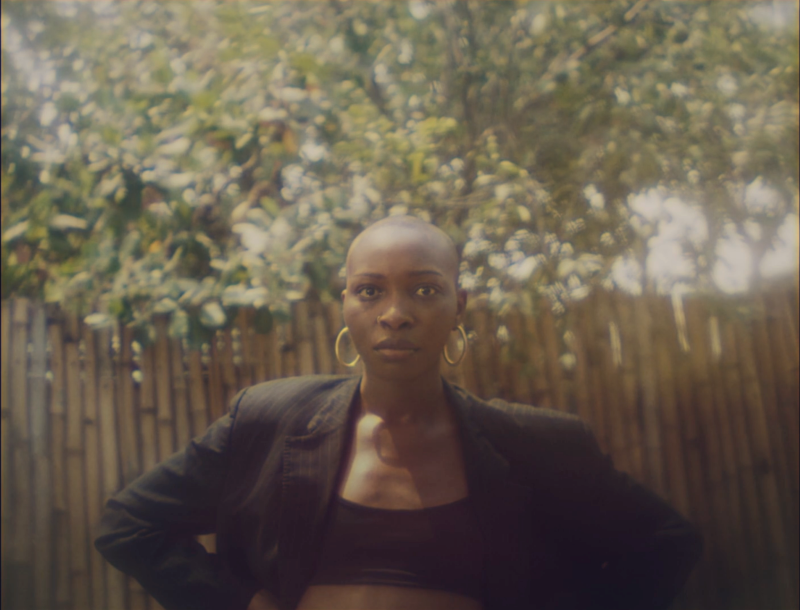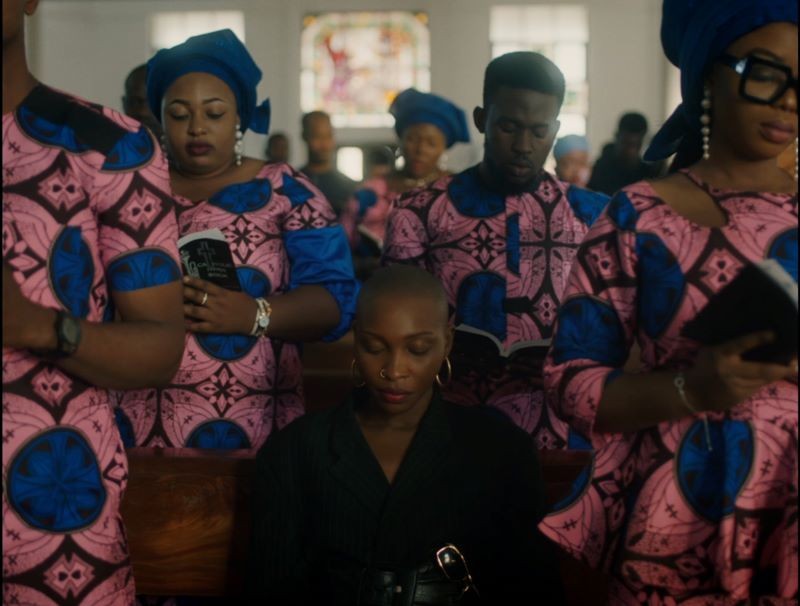Meet the Filmmakers Behind 2022 CUFF: 'Egúngún'
The Columbia University Film Festival (CUFF) is a celebration of the Film Program’s students and alumni, screening shorts from exciting emerging talents, and bringing filmmakers together. For this series, we reached out to the directors of just a few of CUFF’s most unique films to talk about craft, process, and story. In this edition, we talked to Olive Nwosu '21 about the power of the outsider, stripping dialogue away to reveal the truth, and portraying memory in her captivating homecoming film Egúngún.
When I first saw the images for Egúngún, I thought it might be a heist movie; lead actress Sheila Chiamaka Chukwulozie is astride a motorbike in a black suit, everything from her cheekbones to her shades looking dangerous and glamorous. In a way, the film is an adventure, a daring flight; it’s about someone who takes an impulsive journey to catch up to her past.
Collapsing time, weaving past and present—in Egúngún, her latest short film, writer and director Olive Nwosu knows how to create striking images that evoke displacement and illustrate the haunting power of memory.

The film follows Salewa (Chukwulozie), a young woman who has traveled from London to her hometown of Lagos, Nigeria for her mother’s funeral. When she spots her childhood companion Ebun (Teniola Aladese) at the funeral, she goes on something of a side-adventure, following Ebun home.
The piece was commissioned from Nwosu by the British Film Council’s More Films For Freedom Programme, which partners with filmmakers on projects exploring LGBTIQ+ stories.
“I was thinking about a film that was kind of based on my own memories in Lagos, so [the commision] was weirdly serendipitous,” Nwosu told me when we spoke in March. “[The story] was always about these two women, and the two girls that they were, and the experience that bonded them.
"I wanted the film to be integrally about that connection between past and present and memory, and this sense that time continues to happen in its own spheres, and the colliding of these spheres. How we could cinematically create that was the question.”
It’s revealed through flashbacks that Salewa and Ebun, who at the time cleaned for Salewa’s family, had an early romance. We see the two as girls in a garden, dancing under the trees, lying together, flowers in their hair, Salewa brushing a petal on Ebun’s cheek.
One of the film’s most remarkable accomplishments is how it presses the present onto the past, that ‘colliding of spheres’, as Nwosu puts it. The collision is so lyrical and beautiful, it enchants you, even as you realize the impossibility of what you’re seeing: Salewa as an adult appears in the garden of her childhood memory. So does her mother, who shows up in the blue clothes we saw her buried in, in the first shots of the film.
“That’s what memory feels like to me…especially the ones that haunt us, when you haven’t escaped them yet,” Nwosu said.
“We’re trying to convey Salewa and all of her angst, and everything she’s feeling about the day, but also about the place and her relationship with her mother and her identity.” For Nwosu, the memory in the garden became a focal point because it symbolized the intersection of Salewa’s internal conflicts: “If she can find a way to enter [that memory] and make peace, then she can perhaps, perhaps, step forward.”
The funeral takes place during the festival of Egúngún, a Yoruba masquerade celebration centered around uniting communities with departed ancestors. Masquerade is also the English title translation of the film. Nwosu confirmed that the masquerade concept is a way of thinking about Salewa’s divided identity, both how she is playing a part, and her relationship to her home: “that play between our ancestry and fate, and ancestors coming back to us.”
Dialogue throughout the film is intentionally sparse. The film’s visual language speaks with an eloquence beyond spoken words.
“I’m really hesitant around dialogue,” Nwosu said, “I’m about stripping and stripping and stripping as much as possible. I feel like when things are difficult to say, you can rarely ever say them. [I was] stripping away until it felt really truthful.”
Nwosu’s minimalist approach to dialogue meant that physicality and energy were important in casting Aladese and Chukwulozie as Ebun and Salewa.
“The chemistry between the two of them was so important, it was finding not just the right actor but the right chemistry. They just sang off each other. It was really special to watch.”
I mentioned the improvisational feel of a final scene between Ebun and Salewa, and Nwosu confirmed that it was indeed mostly in-the-moment:
“I’d scripted it but I’m a big believer in improv. I get the gist of [what I want] and then throw the script away. Especially for that scene, which I think is really about feeling, and hesitation—things left unsaid that are as crucial as things that are said. We did that scene like, seventeen times. It’s one long shot too, so it takes forever.”
The scene in question feels so natural, the women sitting side by side, talking shyly but warmly, the remembrance of their shared past glowing between them.
“Really not knowing what’s coming, that feels true to life,” Nwosu continued, “They’re really listening to each other. I really encouraged them to sort of push and surprise each other with what they said. So some of their surprise is real surprise.”
Just as she lets her actors convey so much story without scripted dialogue, Nwosu’s visual composition also speaks volumes.
Many prominent sequences isolate Salewa, whether in a crowd or in open space. Nwosu features the angularity of Chukwulozie’s physical performance, drawing attention to the actress’ expressive form by surrounding her with empty space, or simplified backgrounds. At the funeral, while the rest of the family and mourners are standing and singing a hymn, forming a sea of the same pink and blue ankara print, Salewa is sitting center-frame in a pew wearing her black suit. A blank expression on her face, surrounded but detached, Salewa is visibly estranged from her roots.
Chukwulozie’s ability to capture emotion in just a movement of her head and shoulders is all the more impressive because she does some of her best work while she’s on the back of a motorbike.
One of my favorite shots in the piece is Salewa on the back of Ebun’s motorbike as she drives them out to her village home. Chukwulozie inclines her head into the space between Aladese’s nape and head, closing her eyes as if breathing her in, frowning slightly as if the sweetness of being near her again is too much to bear. They do not touch.
Nwosu surrounds them with negative space, letting them drift into the right of the frame, creating an almost sculptural shape. It’s simply stunning.
It turns out Chukwulozie is actually a friend of Nwosu’s. “She’s incredible, she’s just a force,” Nwosu enthused. “Her training is in dancing. She’d done some theater work but not film work. I just thought her presence was so forceful, and when I was thinking about Salewa, her body language is so important. Sheila is so conscious of that, and movement, and presence, so I just thought that she would be great. I had a hunch.”
When Salewa leaves Ebun’s village, this time on the back of a different bike, set against the dusky shadows of the mountains, she turns to look back at Ebun, and places her hand on the seat behind her. She and Ebun watch each other grow smaller, trying to hold the last look they may ever share.
Salewa finally turns her head away, but she keeps her hand placed behind her. This hand, this incline of her shoulder, is turning her back toward Ebun, as if part of her will always be turning back toward Ebun, even as her head is turning to the rest of her life; Salewa will always exist between two places. Once again, Nwosu empties the frame of everything but Salewa, simplifying the image and suspending her in negative space. By creating this visual focus, she invites us to see everything contained in this moment.
If I’m making a lot of these two gestures, it’s because for me, they encapsulate so much of the film: the ache, the sweetness, the longing.
“I think I’m interested in the outsider.” Nwosu said, when I asked her what her films have in common. “I’m interested in the person on the periphery, whose presence causes trouble. My own identities feel so fragmented sometimes, there isn’t any one place that feels like it encompasses all the ways of being I think I have. That’s where the similarity lies: this person who’s looking in, and trying to find their space, while also shaking up spaces.”
This idea of an outsider certainly feels true of Salewa; her longing, her fragmented identity, pulled in different directions, pursuing the past to see what space might still be there for her.
Egúngún has been making waves on the indie circuit, selected at Sundance and the Toronto International Film Festival, nominated for ‘Best British Short Film’ by BIFA, and winner of ‘Best Short Film’ Award at the Hamptons International Film Festival. It’s screening at the Columbia University Film Festival on May 14 at 9pm and is absolutely not to be missed.

